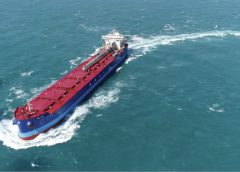If Your Goal Is to Haul Maximum Aggregate, Go Big or Go Home.
By Mark S. Kuhar
Rock Products got in touch with Atul Sabharwal, general manager of Vulica Shipping (a subsidiary of Vulcan Materials Co.), to find out about the company’s latest purchase: a 750-ft.-long vessel that will be used to haul aggregate. It was added to the company’s existing fleet. Read on to learn more. – Ed.
When was the ship ordered; how long does it take to get one of these?
The contract was signed Jan. 29, 2015; the ship was delivered March 12, 2018.
How many ships of this type does the company own?
Houston-based Vulica Shipping, a wholly owned subsidiary of Vulcan Materials Co., owns three Panamax-class, gravity-fed, self-unloading ships. The Ireland, the W.H. Blount, and the H.A. Sklenar are self-unloading bulk carriers and are designed to self-discharge aggregates using conveyor belts.
The Ireland replaces the Quintana, which was retired from service last year. We will also take possession of the James during the second quarter. It will replace the Blount, which will be taken out of service. Vulica Shipping will therefore continue to own and operate three ships, with the Sklenar remaining in service.
What is the ship’s capacity to haul aggregate?
The 750-ft.-long Ireland has the capacity to transport 70,000 tons of aggregates per trip. It was recently named one of the “Great Ships of 2017” in the December issue of Maritime Reporting & Engineering News. The ship’s gravity feed cargo discharge system consists of conveyors and a 260-ft. discharge boom capable of unloading 4,500 metric tons of cargo per hour.

How many in the crew?
The Ireland will have 29 persons in the ship’s company (complement).
Will the ship have a regular route? Which ports will it stop in?
Vulica’s transports crushed limestone from Vulcan’s Calica Quarry in Playa del Carmen, Mexico, to various ports and distribution terminals on the Gulf of Mexico and Atlantic Coast, from Brownsville, Texas, to Jacksonville, Fla., and including Houston, New Orleans, Mobile, Ala., and Tampa.
What type of technology is used for loading and unloading, conveyors, etc.?
The cargo holds have hoppers at the bottom with hydraulically operated gates, the material moves by gravity through the gates onto the two tunnel conveyors, one on the port and the other on the starboard side, which transport the material to the aft (rear) section of the ship where the material is transported by two transfer conveyors to the center of the ship and loads the material onto the C-Loop, which is comprised of two belts that sandwich the material and transport it to the deck. It is then loaded on the discharge boom to be discharged onshore.
Why the name The Ireland?
The ship was named for the founding family of Vulcan Materials Co., the Irelands.

